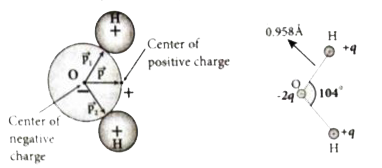Calculate the electric dipole moment for the following charge configurations .
 Solution in Tamil
Solution in Tamil
(i) The electric field lines start at q2 and end at q1 . In figure (a) q2 is positive and q1 is negative . The number of lines starting from q2 is 18 and number of the lines ending at q1 is 6. So q2 has greater magnitud. The ratio of ∣∣∣q1q2∣∣∣=N1N2=68=13 . It implies that |q2|=3|q1|.
(ii) In figure (b) , the number of field lines emanating from both positive charges are equal (N=18). So the charges are equal . At point A the electric field line are denser compared to the lines at point B. So the electric at point A is greater in magnitude compared to the field at point B . Further no electric field line passes through C which implies that the resultant electric field at C due to these two charges is zero .
(iii) In the figure (c) the electric field lines start at q1 and q3 and end at q2 and end at q2 , This implies that q1 and q3 are positive charges. The ratio of the number of field lines is ∣∣∣q1q2∣∣∣=816=∣∣∣q3q2∣∣∣=12 implying that q1 and q3 are half of the magnitude of q2 . So q1=q3=+10n C .
The water molecule (H2O) has this charge configuration . The water molecule has three atoms (two H atom and one O atom ). The centres of positive (H) and negative (O) charges of a water molecule lie at different point hence it possess permanent dipole moment . The O-H bond length is 0.958×10−10 m due to which the electric dipole moment of water molecule has the magnitude p =6.1×10−30 Cm. The electric dipole moment →P is directed from center of negative charge to the center to the center of positive charge asd shown in the figure.

Topper's Solved these Questions
- BOOK - FULL MARKSCHAPTER - ELECTROSTATICS EXERCISE - Textual Evaluation Solved (Multiple choice questions : )15videos
ELECTROSTATICS
- BOOK - FULL MARKSCHAPTER - ELECTROSTATICS EXERCISE - Textual Evaluation Solved (II. Short Answer Questions : )21videos
ELECTROSTATICS
- BOOK - FULL MARKSCHAPTER - DUAL NATURE OF RADIATION AND MATTEREXERCISE - ADDITIONAL QUESTIONS -( ADDITIONAL NUMERICAL PROBLEMS : )10videos
DUAL NATURE OF RADIATION AND MATTER
- BOOK - FULL MARKSCHAPTER - MAGNETISM AND MAGNETIC EFFECTS OF ELECTRIC CURRENT EXERCISE - ADDITIONAL QUESTIONS SOLVED - NUMERICAL PROBLEMS :4videos
MAGNETISM AND MAGNETIC EFFECTS OF ELECTRIC CURRENT
Similar Questions
Two identical point charges'of magnitude -q are fixed as shown in the figure below. A third charge +q is placed midway between the two charges at the point P. Suppose this charge is displaced a small distance from the point P in the directions indicated by the arrows, in which direction(s) will +q be stable with respect to the displacement?
 02:51View Solution
02:51View SolutionWhat is meant by quantisation of charges ?
02:56View SolutionIf a light of wavelength 4950 Å is viewed as a continuous flow of photons, what is the energy of each photon in eV ? (Given h=6.6×10−34Js, c =3×108ms−1)
06:39View SolutionThe radius of the first orbit of hydrogen atom is 0.5 Å. The electron moves is an orbit with a uniform speed of 2.2×106ms−1. What is the magnetic field produced at the centre of the uncleus due to the mation of this electron ? Use μ0=4π×10−7Hm−1 and electric charge =1.6×10−19 C
46:45View SolutionCalculate the magnitude of the force, due to an electric dipole of dipole moment 3.6xx10^(-29) C-m , on an electric 25mm from the center of the dipole , along the dipole axis. Assume that this distance is large relative to the dipole's charge separation.
02:12View SolutionStatement I : Electric dipole moment is a vector quantity.
Statement II : The direction of electric dipole moment is from negative charge to the positive charge.04:14View Solution4 charges are placed each at a distance ‘a’ from origin. The dipole moment of configuration is
View SolutionElectric Dipole| Charge in an Electric field|Elctric Dipole Moment|Electric field intensity due to Electric pole
02:55View SolutionAn electric dipole is formed by +4muC and -4muC charges at 5 mm distance. Calculate the dipole moment and give its direction.
01:51View SolutionA very small electric dipole with dipole moment p is placed in such in way that it is at a distance r from another point charge +q. The point charge lies on the axis of the dipole . Electric dipole moment is pointing towards the point charge. Determine electric dipole will attract the point charge or repel it ? What will be the magnitude of force between them ?
01:09:36View SolutionElectric dipole consists of _____ charges and the electric dipole moment is _____ quantity.
02:59View Solution4 charges are placed each at a distance a from origin . The dipole moment of configuration is . .
04:12View SolutionAn electric dipole is formed by +4μC and −4μC charges at 5 mm distance. Calculate the dipole moment.
View SolutionPoint Charge Electric Field Graphs||Electric Dipole Moment
01:59View SolutionThe electric flux, leaving spherical surface of radius r and surrounding an electric dipole of dipole moment p and charge separation d is
02:09View Solution

